President's Message from 1999 Annual Report
The 20th century witnessed an explosion of medical science, industrialization, and economic progress, with resulting strides in life expectancy and economic prosperity. Will the 21st century bring even more dramatic gains in health and well-being? Or will the United States enter an era of limits on the capacity of the economy and the health system to assure a healthy and prosperous future for all? In particular, will we be able to sustain the health and economic security of older Americans as the baby boom generation reaches retirement after 2010?
To some extent, the future is up to us. Foundations, nonprofit organizations, business, labor, consumer groups, and civic and governmental leaders helped stimulate innovation and change throughout the 20th century, guided by a vision of a common cause in advancing social progress. The challenge for the 21st century is mobilizing the talent, creative thinking, and partnerships required to realize the potential that new advances in knowledge and information hold.
Demography Is Not Destiny
The specter of an aging population has spawned numerous government commissions and scores of legislative proposals to restructure Social Security and Medicare. Long-term projections abound: by one estimate, providing even the same level of benefits for a growing older population could double the share of the gross domestic product (GDP) now supporting those programs over the next 25 to 30 years, with Medicare outlays alone increasing from 2.5 percent of GDP today to 4.4 percent in 2025. Yet many such projections are based on assumptions about economic growth and trends in the health sector that may not be borne out in the long term.
In fact, demography is a relatively minor factor in determining the cost of social goods and services. Consider, for example, total health spending per capita. While it is true that people over age 65 generate health care expenditures about four times as high as those of younger people, aging occurs at a sufficiently slow rate that national levels of health spending are influenced much more by the overall structure of the health system and trends in care than by the age of the population. A cross-national examination finds no relationship between a nation's health spending and the percent of the population over age 65. In 1997, for example, the share of the American population over age 65 was 12.5 percent. In the same year, the elderly populations of the United Kingdom, France, Germany, and Japan were slightly above 16 percent—a rate the United States will reach only by 2020—yet all spent considerably less on health care as a percent of GDP. Further, health spending as a percent of GDP has been remarkably flat in these four countries over the last 15 years, a period during which health spending has risen rapidly in the United States.
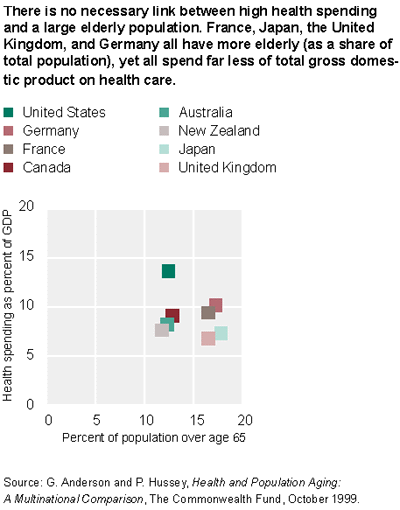
Three major arguments suggest that current projections are uncertain and potentially misleading. First, changes in fertility and immigration rates are as important as changes in life expectancy in affecting future age distribution and the ratio of workers to retirees. While the fact that the U.S. population will grow older on average over the next 30 years is well recognized, there has been less attention to the implications of the growing diversity of the population and the changes in age distribution that may result. Racial and ethnic minorities now represent 28 percent of the U.S. population. By the year 2030, 40 percent of all Americans will belong to these groups. Economic, health, and social changes will be needed to respond to the changing makeup of the U.S. population and deserve much higher priority on the national agenda.
Second, the elderly of tomorrow will be different from those of today. Disability rates and nursing home admission rates have been declining. It is uncertain whether or not those trends will continue, but if they do they will have a marked effect on the demands placed on the health system and the need for long-term care. Even without major breakthroughs in medical research or biotechnology, tomorrow's elderly will be healthier and better educated. Smoking rates have declined. Much more is known about measures that can prevent or delay the onset of functional impairment and contribute to successful aging. Efforts to change behavior and encourage healthier practices could significantly enhance the quality of life in old age.
Third, it is much more the case that economics, not demography, is destiny. Again, assumptions—in this case, about the rate of economic growth—weigh powerfully in future projections. From 1950 to 1997, real GDP grew 3.2 percent annually but slowed in the 1980s and early 1990s. In the last four years, however, economic growth has averaged 4 percent annually. The Congressional Budget Office assumes future economic growth will be 1.5 percent a year. If we experience 3 percent annual economic growth over the next 30 years, average GDP per capita will be almost double what it would be if economic growth were 1 percent ($64,637 as opposed to $33,491, in constant 1998 dollars). Similarly, government expenditures as a percent of GDP could range from 32 percent in 2030, assuming 3 percent real growth, to 61 percent, assuming 1 percent real growth. The nation's capacity to finance health care and assure economic security for the old, while also allowing for higher private consumption and savings, will hinge critically on the future of the economy.
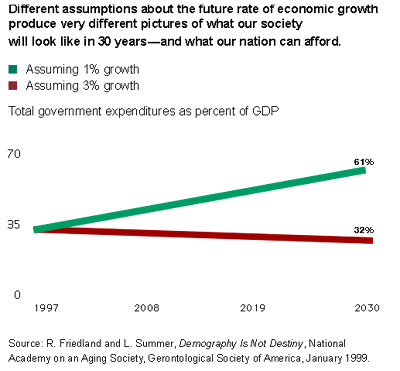
Averages conceal important variations among older people. Over the last two decades, the incomes of working families have become more unequal, and pension and retiree health benefits have covered a declining proportion of workers. Thus, some of tomorrow's elderly will enter retirement in a much less secure financial position than others. Illness or the early death of a spouse can affect economic security, especially for widows in retirement, since single women have much lower incomes on average than do other older Americans. Out-of-pocket medical expenses not covered by Medicare or supplemental insurance also place a major financial burden on the chronically ill.
Policies implemented today that promote economic growth, expand opportunities for older people to use their skills in meaningful work and volunteer activities, share economic prosperity more broadly, protect against the financial losses inflicted by uncovered medical bills for both young and old, improve access to high-quality health care, and promote healthy behaviors will all have significant implications for the future. Our destiny is in our hands; it is not determined by demography alone.
Medicare: Myth versus Reality
The United States is unique among countries in financing health care for the elderly through a governmental program while financing care for working families largely through employer-sponsored health insurance. Thus, a shift in the percentage of the population over age 65 inevitably leads to a shift in the share of total health spending financed by taxes. By 2025, Medicare beneficiaries will be 20.6 percent of the population, up from 13.8 percent in 1998. Concern about the higher taxes needed to finance this change has focused attention on the "Medicare crisis." While it is important to plan for an aging population and debate policy alternatives, myths and confusion currently cloud the discussion.
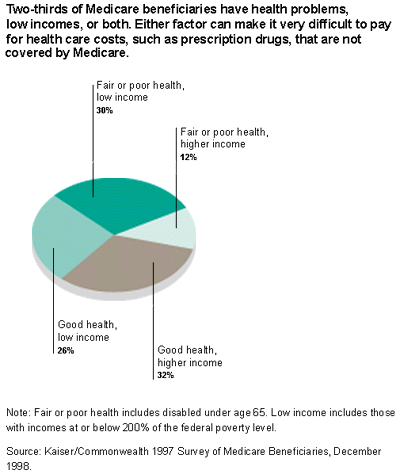
The first major myth is that Medicare beneficiaries are affluent. The reality is that, although incomes vary for older people as they do for younger, most Medicare beneficiaries have modest incomes. Three-quarters have incomes under $25,000, and more than half of women on Medicare have incomes under $10,000. A more accurate portrait of a typical Medicare beneficiary is old, sick, and poor or near poor. A survey by the Henry J. Kaiser Family Foundation and the Fund found that only one-third of Medicare beneficiaries enjoy good health and have incomes above 200 percent of the federal poverty level.
The second myth is that Medicare benefits are too generous, or that the amounts beneficiaries are required to contribute are too low. In fact, Medicare benefits have not improved markedly in the last 35 years. Today, 95 percent of the major health plans offered to employees by medium or large firms cover prescription drugs, but Medicare does not. For the most part, long-term care is not covered either. Medicare's hospital deductible is $768, compared with $201 (in 1998 dollars) when the program started in 1966; the Part B annual premium is $546, compared with $181 at the program's outset.
As a result, most Medicare beneficiaries, unlike workers covered by employer-financed coverage, need supplemental insurance. Only 34 percent of Medicare beneficiaries now get retiree health benefits through their former employers, and this share will decline in the future. For those who must purchase supplemental coverage, the typical premium for a policy purchased individually is approximately $1,250 annually. These premiums and non-covered services account for the fact that the typical Medicare beneficiary pays $2,600 for health care each year, or nearly 20 percent of income. By contrast, non-elderly families spend about 8 percent of income on out-of-pocket health care costs. Any proposal to shift more costs from working years to retirement would further widen this disparity and add to the savings required to finance retirement.
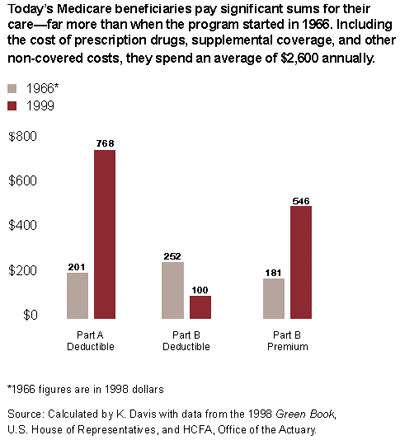
The high expenses incurred by Medicare beneficiaries, coupled with their modest incomes, make it clear that the potential to finance health spending for an aging population through higher beneficiary contributions is quite limited. Projections indicate that by 2025 Medicare beneficiaries will be spending 29 percent of income on their own health care. For those who have serious health problems or below-average incomes, an even higher share of income will be devoted to health care. Although a small minority of future retirees will enter old age with substantial savings and income from pensions and investments, those same individuals will have contributed more to Medicare while working (since there is no longer a ceiling on earnings subject to the Part A payroll tax) and will continue to contribute more through income taxes that help finance Medicare Part B.
The third myth is that Medicare is inefficient and costly, and that the "Medicare crisis" could be averted if the program were reformed to rely more on managed care and market competition among private insurers. In fact, Medicare has a history of remarkable administrative efficiency. Its administrative costs average less than 2 percent, compared with 10-15 percent in employer group coverage and 30-50 percent in individual private health insurance. Medicare expenses per beneficiary have risen at the same rate over the last 25 years as private health insurance costs per covered person for comparable benefits. Given the sharp curtailment of payments to managed care plans, hospitals, physicians, and other health care providers as specified in the 1997 Balanced Budget Act, Medicare spending is projected to grow much more slowly than private insurance costs over the next five years.
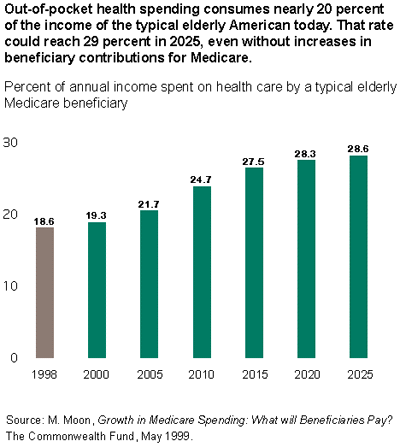
Medicare already makes about 300 managed care plans available to beneficiaries, and about 14 percent of beneficiaries—6 million—belong to those plans. The value of this option is still in question. The Medicare managed care industry is experiencing considerable turbulence, and some health plans have left selected markets, raised premiums, or trimmed benefits. Current estimates indicate that Medicare pays about 6 percent more for each beneficiary enrolled in managed care than it does for those who remain in traditional Medicare. Efforts to test competitive bidding or other incentives to reduce costs have encountered considerable resistance. New methods of paying plans on the basis of health risks have not yet been adopted, and the first open enrollment season—during which beneficiaries were supposed to be informed more fully about their choices—met with only mixed success.
One proposal under consideration, called "premium support," would further "privatize" Medicare. Under this approach the federal government, rather than paying directly for care through traditional Medicare or managed care plans, would contribute a fixed sum that beneficiaries could apply toward the cost of their care. Beneficiaries would be responsible for the difference between the actual cost and the government's contribution.
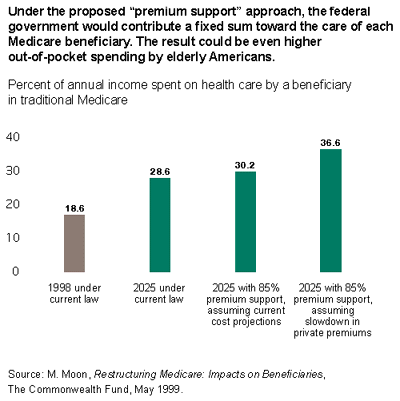
The Health Care Financing Administration has estimated (based in part on a proposal to set the federal contribution at 88 percent of the median private managed care premium) that premium support and other provisions such as raising the age of eligibility to 67 could help save about 11 percent of Medicare outlays over the next 30 years. Yet most of these "savings" are costs shifted to beneficiaries. Under the proposal, beneficiaries would pay $5,000 per person in 2025 (in 1998 dollars), or about 30 percent of income, for their own care. Savings also depend on the untested assumption that competition among plans would lead to lower premiums over time. And, if private managed care premiums were indeed to fall, the cost to beneficiaries of remaining in traditional Medicare could rise substantially, consuming 37 percent of income by 2025.
Options for restructuring Medicare are likely to be the subject of intense debate over the next few years. The Medicare Part A hospital fund will be exhausted in 2015. The absence of an immediate deadline for action has the advantage of permitting a more thorough discussion of how best to finance health care for an aging population in the 21st century. It also grants time to assess the validity of a more optimistic view of economic growth, the progress of medical research, and the health of an aging population.
The optimists call for dedicating a portion of the federal budget surplus to Medicare and expanding benefits to include prescription drugs. Savings would be achieved by extending limits on payments to health care providers beyond 2002, when the Balanced Budget Act provisions expire. Some additional payments by beneficiaries would be required through partial premiums, coinsurance for prescription drug coverage, and other measures. Also, steps might be taken to restructure financial contributions from beneficiaries to provide greater protection to the poor and sick while collecting premiums from those with more substantial incomes.
Close monitoring, solid information about options, and addressing some of the factors that undermine health and economic security in retirement could all contribute to a healthier and more prosperous nation in the 21st century. The Fund will continue to advance understanding of the issues by projecting trends, simulating policy options, and analyzing specific proposals through its Program on Medicare's Future.
Long-Term Care and End-of-Life Care
The aging of the population also has implications for long-term and end-of-life care. Under the current system, with Medicaid the predominant source of payment for nursing home care, many older Americans face the undignified prospect of exhausting their savings to the point of impoverishment before qualifying for assistance with long-term care expenses. Until our nation adopts a financing system capable of accommodating the needs of Americans across the income spectrum, the personal and financial issues associated with long-term care can only grow more difficult.
Recent estimates indicate that the number of elderly people with long-term care needs will rise substantially, from 8.7 million today to 12 million by 2030. The services required are diverse, ranging from care in a nursing home to personal care at home. A year in a nursing home costs around $40,000 on average, and twice that in some states. Medicare, Medicaid, and other government programs (such as the Veterans Administration) cover about two-thirds of the nation's $115 billion annual spending on long-term care. About 28 percent of those costs are paid directly by families; only 7 percent are covered by private insurance.
Projections of future national spending on long-term care for the elderly indicate continued growth as more baby boomers reach age 65 and more elderly live to be 85 years or older. Total spending is expected to rise to $346 billion by 2040 (in 2000 dollars), of which two-thirds would pay for nursing home care. Rising expenditures for long-term care have important implications for the Medicaid program. By 2040, Medicaid outlays for long-term care are expected to reach $125 billion (in 2000 dollars), up from $43 billion in the year 2000, and the projected financial burden on families is also substantial.
Yet most people's fears about long-term care are not primarily financial. Rather, the dearth of high-quality care options that are responsive to the preferences of patients and their families is more troubling. The quality of personal care in nursing homes is frequently deficient, the standards that do exist are often poorly enforced, and families have little information on which to make informed decisions. Not surprisingly, most people would prefer to be cared for at home, but finding and paying for qualified home care can be an insurmountable task.
Developing a better approach to financing and delivering long-term care services is a major challenge facing health care leaders and policy officials—and one that has received very little attention. We enter the 21st century without a basic system of financing long-term care, adequate standards to govern quality of care, or a shared understanding of the best approaches to providing care that is sensitive to patient and family preferences. The Fund is helping to build a base of knowledge through its support for quality measurements in nursing homes and dissemination of information to those who can act on it, from family members to state nursing home inspectors.
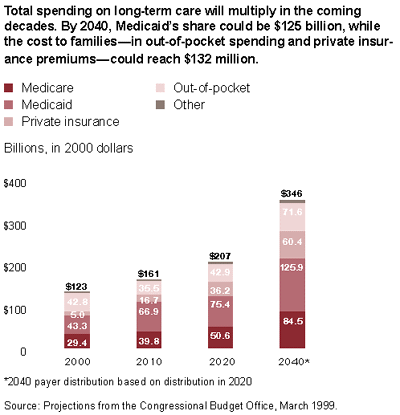
Yet the experience of other countries is heartening. Denmark, for example, cut nursing home use per person over age 67 by 27 percent between 1982 and 1996; it also provides universal home care, using salaried nurses and trained aides employed by municipal governments. The cost to government of this publicly financed system is approximately 2.3 percent of GDP, although the percentage of elderly is already higher in Denmark than it is projected to be in the United States in 20 years' time. This and other potentially valuable lessons emerged from an international symposium sponsored by the Fund in October 1999 on cross-national approaches to financing and delivering quality long-term care.
Care for the terminally ill is also a much-neglected issue. A survey of terminally ill patients and family caregivers supported by the Nathan Cummings Foundation and the Fund finds that the current system often fails to meet the needs of families. Burdens on caregivers are substantial, and uncovered expenses can be financially devastating, even to middle class families. These findings shed some light on approaches that could make end-of-life care more responsive to the preferences of patients and families and on the need for greater support for family members and improved financial protection for services such as prescription drugs.
Opportunities to Promote Healthier Old Age
One obvious but undervalued strategy for addressing the aging of the population is to become much more methodical about understanding and promoting healthier old age. This is the fundamental premise of the Beeson Scholars Program, supported by the John A. Hartford Foundation, donor friends of the Alliance for Aging Research, and the Fund, which seeks to increase medical research on aging and attract physician scientists to the field. The program is expanding the pool of talented young investigators committed to research on aging, while also building a network capable of employing that knowledge for practical purposes.
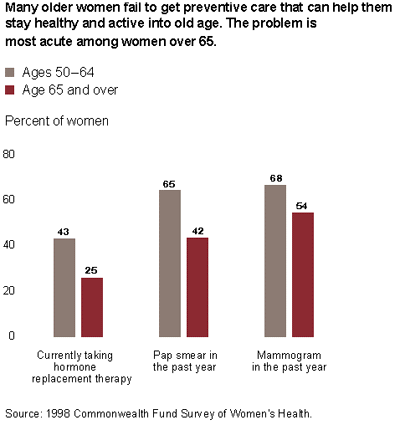
Indeed, much more could be done to apply what is already known to improve the health and quality of life of older people. At Yale-New Haven Hospital, for example, a project funded in part by the National Institute on Aging, the Retirement Research Foundation, local funders, and the Fund sought to prevent delirium among older, at-risk hospitalized patients. An evaluation showed that the project succeeded in reducing the incidence of delirium by 40 percent, at a savings in hospital charges of $2,000 per patient. The intervention, known as the Elder Life Program, uses trained volunteers to walk patients three times a day, help them remain oriented, provide cognitive stimulation, enhance sleeping at night through relaxation techniques, and identify and correct visual and hearing impairment. The challenge is to make this a standard of care for all hospitals.
Missed opportunities to prevent morbidity and mortality exist for all ages, but the situation is particularly serious for older people. A RAND study supported by the Fund found that only about half of people with hypertension have their condition controlled, only half of diabetics receive regular eye exams, and only one-tenth of people with a current depressive disorder receive antidepressant medications.
Inadequate preventive care is common. Although the risk of cancer is highest among older people, older women are less likely to receive regular mammograms and Pap smears than younger women. Almost half of women over 65 fail to get a regular mammogram, and more than half do not get a regular Pap smear. Rates of regular colon cancer screening are also quite low for this age group: 26 percent of women and 41 percent of men. The Commonwealth Fund 1998 Survey of Women's Health found that only 47 percent of women over age 65 are very familiar with osteoporosis and only 57 percent take calcium supplements. Hormone replacement therapy has significant benefits in reducing risks of heart disease and osteoporosis, but only 25 percent of older women receive such therapy, and only 26 percent receive any counseling from their physicians about this option.
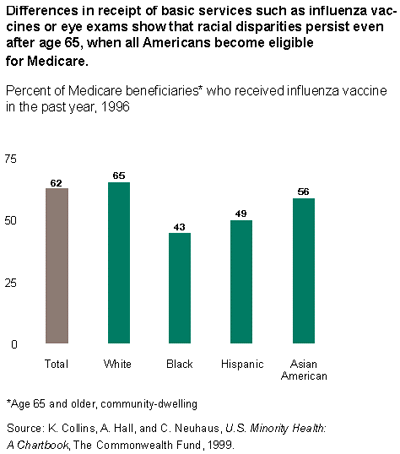
Minority elderly are even more at risk. Only 43 percent of black elderly received an influenza vaccine in the past year, compared with 65 percent of white elderly. Minority elderly Medicare beneficiaries are less likely to receive specialized services, such as angioplasty, coronary artery bypass graft surgery, or hip fracture repair.
If we are serious about assuring a healthy and prosperous old age for all, we will need to adopt a more systematic approach to assuring high-quality care and applying what is known about health-enhancing and preventive measures. The Fund is contributing to this effort by supporting the development of Health Employer Data Information Set (HEDIS) quality measures, which are used to assess the performance of managed care plans. New categories will include, for example, physician counseling for postmenopausal women on the benefits and risks of hormone replacement therapy. The Fund also supports efforts to extend innovative models, such as the program at Yale-New Haven Hospital. But these are just a beginning. Until we as a nation make prevention and quality of care a top priority, we will continue to miss opportunities to enhance the quality of life in old age.
Future Challenges
Continued strong economic growth holds the key to a prosperous future for all Americans. The government, business, and nonprofit sectors have all contributed to the most recent upturn in productivity and, working in concert, can assure its continuation in the 21st century. Low unemployment provides opportunities for more Americans—minorities, single mothers, immigrants, people with disabilities, and older people—to contribute to and share in economic prosperity.
A key to continued growth is investment early in life to assure that all children grow up healthy and productive. Along with more than 70 cofunders, the Fund has invested in a new approach to pediatric care called Healthy Steps, which provides parents with information and services to promote the cognitive, behavioral, and social development of their infants from birth to age three. This and other innovations can do much to build a strong labor force by assuring that all children reach school age ready and able to learn.
But older Americans can also continue to contribute in meaningful ways to work, family, and community life. The Fund's earlier Americans Over 55 at Work Program demonstrated that many older people are ready, able, and willing to work but lack opportunities because of deeply held biases about the adaptability and productivity of older workers. Older people can also contribute significantly through volunteer activities. A Fund-supported survey found that mentors can help guide young people into further education and productive careers. The Elder Life Program to prevent delirium also demonstrated a valuable role for volunteers. Using volunteers more creatively in ospitals, nursing homes, and other settings could enhance quality of life and reduce the cost to society of health and long-term care.
Shared economic prosperity is also essential to a better future. Parents who earn a decent wage can provide more opportunities for their children to develop to their full potential. Families with good health insurance are more likely to get care that prevents illness and disability, and are better protected from the financial burdens of uncovered medical bills. The Fund's new Task Force on the Future of Health Insurance for Working Americans is dedicated explicitly to the needs of uninsured and low wage workers. We all have a common cause in assuring that people enter retirement in good health and economically secure, not sick and poor. Paying for health and long-term care for an aging population will be easier if tomorrow's Medicare beneficiaries and workers are well prepared.
Another important goal is to assure that the American health care system is driven to achieve excellence. The preoccupation in the last quarter century with slowing the growth of health care costs has shifted attention away from technological innovation and high-quality care. Indeed, the Fund's Task Force on Academic Health Centers has shown that managed care is eroding the nation's medical research capacity and undermining the social missions of academic health centers. Yet, over the last half of the 20th century, the greatest gains in health, life expectancy, and functioning have come from advances in medical science and improvements in specialized care, whether drug discoveries or new techniques in cardiac, cataract, orthopedic, and other types of surgery.
Leaders in medicine and health care institutions are increasingly frustrated by constraints on their ability to provide the kind of care that patients want and need, and by a reward system that appears not to value excellence in patient care or innovation. A medical practice that spends time on patient education whether about diabetes, hormone replacement therapy, or child development must do so at an economic loss. The Fund's Survey of Physician Experiences with Managed Care found that two-fifths of physicians say they have less ability than they did three years ago to make decisions they think are right for their patients. An equal proportion report that they are spending less time with patients.
The United States spends more on health care per capita than any other country by a factor of two. Incentives to improve efficiency and reduce inappropriate or unnecessary care are important. But equally important is a health system that rewards physicians whose patients have their hypertension or diabetes well controlled and understand the options available to them to reduce the risk of future disease and disability. Advances in information technology hold great promise for engaging patients in their own care decisions, improving physician-patient communication, promoting healthy behavior, feeding individual and comparative information back to providers, and preventing medical errors through "real time" information systems that are readily accessible. We are just at the beginning of our ability to tap information technology as a powerful tool to transform American medicine.
Compared with these challenges, financing health and long-term care for an aging population should be relatively straightforward. Efforts to date have searched for a painless magic bullet, a cure-all that would permit more
comprehensive benefits, reduce costs to beneficiaries, impose no new taxes, and maintain rates of payment to hospitals, physicians, and other providers of services. Managed care and the privatization of Medicare are not panaceas.
Medicare was enacted in 1965 because private insurers would not provide adequate coverage for American retirees. Since then, it has served a very important function by covering all, regardless of income or health status. As the program is updated, this essential feature should be protected. Fortunately, a stronger-than-anticipated economy, along with the Balanced Budget Act of 1997—which tightened payment rates to health care providers—have assured Medicare's solvency for the next 15 years. This reprieve should give the nation an opportunity to explore a range of realistic, long-term options to assure the health of older Americans in the 21st century and promote excellence in care, as Medicare has done so well during the last third of the 20th century.
There is no comparable base for building a 21st century approach to long-term care financing. Today, Medicaid is the major source of financing for nursing home and home- and community-based care for those who cannot care for themselves, but it is available only after all savings are exhausted. Quality of care is a serious concern: despite some recent improvements, such as reductions in the use of restraints, instances of substandard care are far too common. More fundamentally, families have no assurance that there are choices available that will permit their family members to receive kind, loving care in the twilight of life. Other countries have already grappled with many of these issues, in part because they have already experienced the aging that will overtake the United States in the next few decades. Cross-national exchange of experiences affords some promise of building on proven models of care.
Advances have made health care more patient-centered. Through the work of the Fund-supported Picker Institute and others, hospitals now routinely survey discharged patients about their experiences, and consumer assessment of managed care plans has become standard practice. Employers and consumers are beginning to use quality information to make more informed choices, but to a very limited extent. Feeding back information to plans and providers appears to be having a growing impact. And some purchasers (whether employers or managed care plans) are beginning to develop incentives to reward excellence. It is an opportune time to begin to take the concepts of patient-centered care into the arenas of long-term care and care of the dying. Listening to patients and families is an important first step.
It is sometimes said that only in America is death viewed as an option. But the possibility of a healthier, longer life may become a reality in the 21st century. Advances in medical research and biotechnology may unlock the secrets of disease and, through gene therapy and other techniques, eliminate some of the major causes of disability and premature mortality. No one can predict the future course of health and disability, but much can be done today to make sure that what is known to be beneficial is more broadly available.
No other sector of the American economy would tolerate the high rate of failure that prevails in American health care: the children who are not immunized, the adolescents who begin risky behaviors that have lifetime health consequences, the women who are not familiar with the steps they can take to reduce their risks of osteoporosis and heart disease, the men and women whose cancer is not detected at an early stage when the promise of cure is high, and the elderly whose hypertension, diabetes, and depression are not controlled. We can do better as a nation. And in doing better, we can lighten the burden on families, increase the quality of life, and contribute to increased labor productivity and economic growth.
Achieving these goals will take a wholehearted commitment to excellence for all. We cannot continue with a health system that excludes some of our people because they lack health insurance or because of their race, ethnicity, or income. Nor can we continue to be blind to shortcomings in the present system. Rather, we need to harness all the resources at our Command—including the potential of new information technology, visionary health care leaders, and dedicated health professionals—to improve the performance of the health system and reduce missed opportunities. These are just some of the priorities the Fund hopes to address through programs to improve health care services in general and the health of minority Americans, the elderly, and children in particular.
It is an exciting challenge, worthy of a new century. In embracing that challenge, the Fund pledges to draw on its historic strengths: a commitment to social progress, a tradition of scientific inquiry, partnership with others who share common concerns, effective use of communications, and mobilizing talented people to take on the challenges ahead. This Annual Report sets forth the Fund's efforts over the past year and outlines the major programs through which we hope to tackle the tasks ahead.


